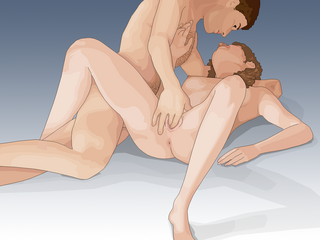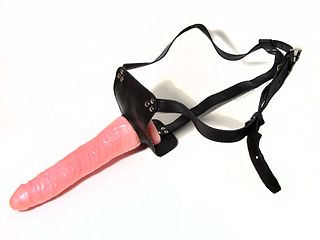
Orgasm or sexual climax is the sudden discharge of accumulated sexual excitement during the sexual response cycle, resulting in rhythmic, involuntary muscular contractions in the pelvic region characterized by sexual pleasure. Experienced by males and females, orgasms are controlled by the involuntary or autonomic nervous system. They are usually associated with involuntary actions, including muscular spasms in multiple areas of the body, a general euphoric sensation, and, frequently, body movements and vocalizations. The period after orgasm is typically a relaxing experience, attributed to the release of the neurohormones oxytocin and prolactin as well as endorphins.

The G-spot, also called the Gräfenberg spot, is characterized as an erogenous area of the vagina that, when stimulated, may lead to strong sexual arousal, powerful orgasms and potential female ejaculation. It is typically reported to be located 5–8 cm (2–3 in) up the front (anterior) vaginal wall between the vaginal opening and the urethra and is a sensitive area that may be part of the female prostate.

A sex toy is an object or device that is primarily used to facilitate sexual pleasure, such as a dildo, artificial vagina or vibrator. Many popular sex toys are designed to resemble human genitals, and may be vibrating or non-vibrating. The term sex toy can also include BDSM apparatus and sex furniture such as sex swings; however, it is not applied to items such as birth control, pornography, or condoms. Alternative terms for sex toy include adult toy and the dated euphemism marital aid. Marital aid also has a broader meaning and is applied to drugs and herbs marketed to enhance or prolong sex.

A cock ring or cockring is a ring worn around the penis, usually at the base. The primary purpose of wearing a cock ring is to restrict the flow of blood from the erect penis to produce a stronger erection or to maintain an erection for a longer period of time. They are sometimes used as medical devices, on their own or in conjunction with a penis pump to assist in the management of erectile dysfunction. Genital adornment is another purpose, as is repositioning the genitals to provide an enhanced appearance.

Erotic massage is the use of massage techniques by one person on another person's erogenous zones for their sexual pleasure. The process may achieve or enhance the recipient's sexual excitation or arousal and sometimes achieve orgasm. The person providing the massage is called a masseur (male) or masseuse (female). Massages have been used for medical purposes for a very long time, and their use for erotic purposes also has a long history. In the case of women, the two focal areas are the breasts and pubis, while in case of men, the focal areas are the male breast muscles and nipples, male genitals, the anus, and the prostate. When the massage is of a partner's genitals, the act is usually referred to as a handjob for penises and fingering for vulvas.

Prostate massage is the massage or stimulation of the male prostate gland for medical purposes or sexual stimulation.

Fingering is sexual stimulation of the vulva or vagina by using the fingers. Vaginal fingering is legally and medically called digital penetration or digital penetration of the vagina. The term "digital" takes its significance from the English word 'digit', which refers to a finger, thumb, or toe. Fingering may also include the use of fingers to stimulate the anus.

A forced orgasm is consensual BDSM or kinky sexual play whereby a person consents to be forced to orgasm in a way that is beyond their control.

A strap-on dildo is a dildo designed to be worn, usually with a harness, during sexual activity. Harnesses and dildos are made in a wide variety of styles, with variations in how the harness fits the wearer, how the dildo attaches to the harness, as well as various features intended to facilitate stimulation of the wearer or a sexual partner. Strap-on dildos are most frequently used by lesbian women, but can be used by people of any gender or sexuality.

A love egg is a type of egg or bullet shaped vibrator that is used for stimulation. They can also be referred to as egg vibrators or bullet vibrators, depending on their shape. They are typically weaker than larger external vibrators, such as wands, but are still popular due to their lower price and discreet nature. The primary purpose of these vibrators is targeted stimulation of internal or external erogenous zones.

A rabbit vibrator is a vibrating sex toy, usually made in the shape of a phallic shaft for vaginal stimulation with a clitoral stimulator attached to the shaft. The device's name is derived from the fact that the clitoral stimulator looks like a pair of rabbit ears. The first rabbit vibrator appeared on the market in 1984 and, along with the magic wand vibrator, is considered by Cosmopolitan magazine to be one of the classic sex toys.

A clitoral pump is a sex toy designed for sexual pleasure that is applied to the clitoris to create suction and increase blood flow and sensitivity. A clitoral pump is designed to be used on the entire external clitoris including the clitoral hood. Other designs of pump exist for the labia, the entire vulva and, in some cases, the nipples.

A G-spot vibrator is a sex toy with female and male varieties. The female version of the device is built to massage the G-spot, described as a bean-shaped area of the vagina. Some women report that it is an erogenous zone which, when stimulated, can lead to strong sexual arousal, powerful orgasms and female ejaculation. The male version of the G-spot vibrator is used for massaging the prostate for both sexual and health-related reasons.
A double penetration dildo or double dildo is a type of sex toy used for double penetration, the simultaneous entry of two body orifices at the same time, belonging to either one or two people. It is a dildo designed in the form of two penetrative stimulators that are either separate or fixed on a single shaft. Some double penetration dildos include a vibrating motor that allows them to be used as double penetration vibrators.

An anal vibrator is a vibrator designed for sexual stimulation of the anus of both men and women. All anal vibrators have one common feature: they produce a vibrating effect in the rectum for pleasurable sensations.

Clitoral vibrators are vibrators designed to externally stimulate the clitoris for sexual pleasure and orgasm. They are sex toys created for massaging the clitoris, and are not penetrating sex toys, although the shape of some vibrators allows for penetration and the stimulation of inner erogenous zones for extra sexual pleasure.

The Magic Wand aka the True Magic Wand,Magic Wand Original, Vibratex Magic Wand and Original Magic Wand) is an AC-powered wand vibrator. It was originally manufactured for relieving tension and relaxing sore muscles; however, it is most known for its use as a sex toy. Japanese company Hitachi listed the device for business in the United States in 1968. Sex educator Betty Dodson popularized its use as a vibrator and masturbation aid for women during the sex-positive movement in the late 1960s. It functions effectively as a clitoral vibrator, to bring people to orgasm. The wand is 12 inches (30 cm) long and weighs 1.2 pounds (540 g) with stimulation provided by its rubberized 2.5-inch (64 mm) head.

Sexual activities involving women who have sex with women (WSW), regardless of their sexual orientation or sexual identity, can include oral sex, manual sex, or tribadism.

A sex machine is a mechanical device used to simulate human sexual intercourse or other sexual activity.
Hallie Lieberman is an American writer and a sex and gender historian. Her first book, Buzz: The Stimulating History of the Sex Toy (2017) traces the history of sex toys in the USA from the 1950s to the present. Lieberman teaches science and technology journalism at the Georgia Institute of Technology.
























